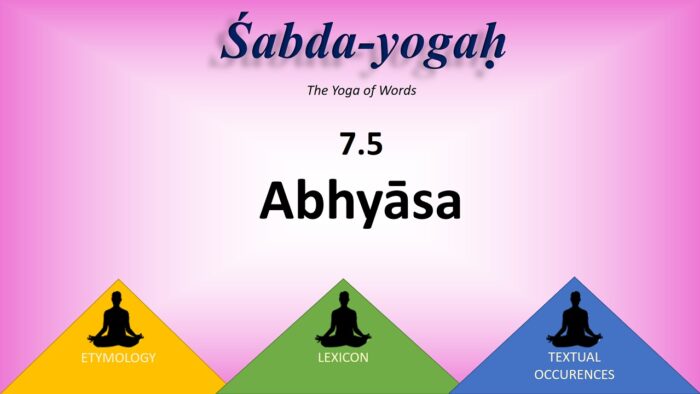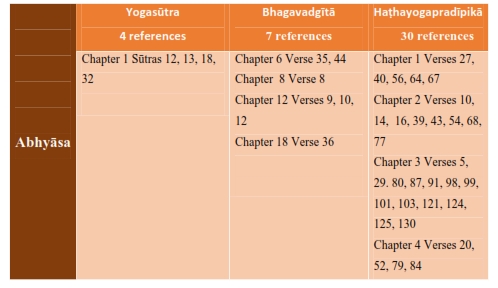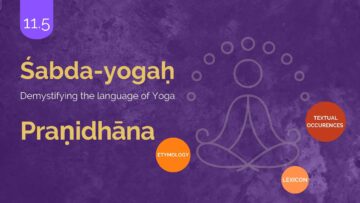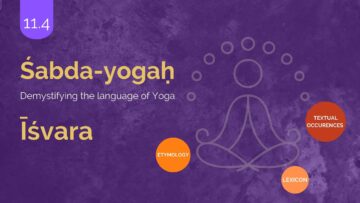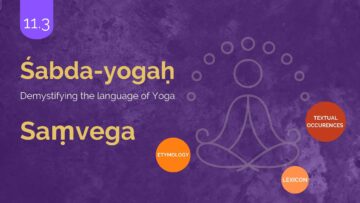Introduction
In this series, Yogic terminologies will be taken up and their –
- Etymological analysis,
- Lexical descriptions and
- Textual occurrences in Yogic literature and their commentaries, as available, will be presented. And finally observations will be made on the references.
Three texts – Yogasūtra, Haṭha-yoga-pradīpikā and Bhagavad-gītā are consulted for textual occurrences portion.
Śabda-yoga is intended to help students, teachers, and professionals of Yoga to develop a sound grammatical, contextual, and thereby an authentic and immersive understanding of Yoga terminologies.
7.5 Abhyāsa
Etymology
अभि+अस्+घञ् = अभ्यासः
abhi+as+ghañ = abhyāsaḥ
अभि abhi is the prefix that is used in the sense[1] of सांमुख्यsāṃmukhya/आभिमुख्य or ābhimukhya – towards and आम्नायāmnāya – to remember well
अस् as is the root. The meaning of the root is क्षेपे – to throw
घञ् ghañ is the suffix added to indicate the act. This suffix is added as per the grammatical rule भावे bhāve (aṣṭādhyāyī3.3.18)
The derivate statement to the word would then be –
आभिमुख्येन अस्यते क्षिप्यते इति – ābhimukhyena asyate kṣipyate iti – It indicates the act of throwing towards. Throwing here may refer to channelizing. Channelizing one’s effort towards a specific task.
Lexicon– This term is not found in the Amarakosha.
Textual Occurrences
Yogasūtras
There are four references to the term Abhyāsa in the text. It is interesting to note that all the four references are found in the first chapter itself. The references are as follows-
अभ्यासवैराग्याभ्यां तन्निरोधः ॥ १.१२ ॥
तत्र स्थितौ यत्नाऽभ्यासः ॥ १.१३ ॥
विरामप्रत्ययाभ्यासपूर्वः संस्कारशेषोऽन्यः ॥ १.१८ ॥
तत्प्रतिषेधार्थमेकतत्त्वाभ्यासः ॥ १.३२ ॥
abhyāsavairāgyābhyāṃ tannirodhaḥ .. 1.12 ..
tatra sthitau yatnā’bhyāsaḥ .. 1.13 ..
virāmapratyayābhyāsapūrvaḥ saṃskāraśeṣo’nyaḥ .. 1.18 ..
tatpratiṣedhārthamekatattvābhyāsaḥ .. 1.32 ..
Sūtra1.12 – states that the twin methods of Abhyāsa and Vairāgya are needed to attain citta-vṛtti-nirodha. Sūtra 1.13 defines abhyāsa as the effort towards attaining sthiti – stillness of the mind without any vṛttis. Sūtra 1.18 states that the state of asaṃprajñāta-samādhi can be attained by abhyāsa of the cause (para-vairāgya) that leads to the cessation of the activities of the mind. Sūtra 1.32 states that to overcome the obstacles in the path of Yoga abhyāsa of one tattva has to be done.
Bhagavadgītā
There are seven references to the term Abhyāsa in Bhagavadgītā. They are present in chapters 6, 8, 12 and 18. They references are as follows –
असंशयं महाबाहो मनो दुर्निग्रहं चलम् ।
अभ्यासेन तु कौन्तेय वैराग्येण च गृह्यते ॥ ६. ३५ ॥
पूर्वाभ्यासेन तेनैव ह्रियते ह्यवशोऽपि सः ।
जिज्ञासुरपि योगस्य शब्दब्रह्मातिवर्तते ॥ ६. ४४ ॥
अभ्यासयोगयुक्तेन चेतसा नान्यगामिना ।
परमं पुरुषं दिव्यं याति पार्थानुचिन्तयन् ॥ ८.८ ॥
अथ चित्तं समाधातुं न शक्नोषि मयि स्थिरम् ।
अभ्यासयोगेन ततो मामिच्छाप्तुं धनञ्जय ॥ १२.९ ॥
अभ्यासेऽप्यसमर्थोऽसि मत्कर्मपरमो भव ।
मदर्थमपि कर्माणि कुर्वन्सिद्धिमवाप्स्यसि ॥ १२.१० ॥
श्रेयो हि ज्ञानमभ्यासाज्ज्ञानाद्ध्यानं विशिष्यते ।
ध्यानात्कर्मफलत्यागस्त्यागाच्छान्तिरनन्तरम् ॥ १२.१२ ॥
सुखं त्विदानीं त्रिविधं शृणु मे भरतर्षभ ।
अभ्यासाद्रमते यत्र दुःखान्तं च निगच्छति ॥ १८.३६ ॥
asaṃśayaṃ mahābāho mano durnigrahaṃ calam .
abhyāsena tu kaunteya vairāgyeṇa ca gṛhyate .. 6. 35 ..
pūrvābhyāsena tenaiva hriyate hyavaśo’pi saḥ .
jijñāsurapi yogasya śabdabrahmātivartate .. 6. 44 ..
abhyāsayogayuktena cetasā nānyagāminā .
paramaṃ puruṣaṃ divyaṃ yāti pārthānucintayan .. 8.8 ..
atha cittaṃ samādhātuṃ na śaknoṣi mayi sthiram .
abhyāsayogena tato māmicchāptuṃ dhanañjaya .. 12.9 ..
abhyāse’pyasamartho’si matkarmaparamo bhava .
madarthamapi karmāṇi kurvansiddhimavāpsyasi .. 12.10 ..
śreyo hi jñānamabhyāsājjñānāddhyānaṃ viśiṣyate .
dhyānātkarmaphalatyāgastyāgācchāntiranantaram .. 12.12 ..
sukhaṃ tvidānīṃ trividhaṃ śṛṇu me bharatarṣabha .
abhyāsādramate yatra duḥkhāntaṃ ca nigacchati .. 18.36 ..
Summary: In the context of Dhyānayoga, in verse 6.35 Abhyāsa and Vairāgya have been stated as the means to reduce the distractions of the mind and regulate it. In the same chapter verse 44 states the efficacy of Abhyāsa of Yoga in earlier births in orienting a practitioner towards Yoga in subsequent birth. In verse 8.8, Abhyāsa yoga is presented as the means to attain the divine ultimate consciousness. According to śrī-śaṅkara-bhagavatpādaabhyāsayoga refers to the effort to surrender the mind to the Lord and not allowing other thoughts to deflect and distract the mind. (चित्तसमर्पणविषयभूते एकस्मिन् तुल्यप्रत्ययावृत्तिलक्षणः विलक्षणप्रत्ययानन्तरितः अभ्यासः स चाभ्यासो योगःcittasamarpaṇaviṣayabhūte ekasmin tulyapratyayāvṛttilakṣaṇaḥ vilakṣaṇapratyayānantaritaḥ abhyāsaḥ sa cābhyāso yogaḥ). Verse 12.9 also mentions about Abhyāsa Yoga. It is interesting to note that in this context,Abhyāsa Yoga is described by śrī-śaṅkara-bhagavatpāda as the effort the make the mind focused on a single object by again and again bringing it from wherever it wanders to (चित्तस्य एकस्मिन् आलम्बने सर्वतः समाहृत्य पुनः पुनः स्थापनम् अभ्यासःcittasya ekasmin ālambane sarvataḥ samāhṛtya punaḥ punaḥ sthāpanam abhyāsaḥ) . The subsequent verse also mentions about Abhyāsa (12.10). Herein it is stated that if one is not able to do the aforementioned abhyāsa it is advised to all work for the Lord. Verse 12.12 glorifies Karma-phala-tyāga – renunciation of the results of work. This verse places karphala-tyāga above knowledge, the aforementioned abhyāsa and Dhyāna. Verse 18.36 marks the commencement of discussion on three fold division of Sukha. It has been stated here that, by (learning and) doing abhyāsa of this (the ideas discussed here) one becomes free from sufferings.
Haṭhayogapradīpikā
There are 30 references to the use of the word abhyāsa in this text. All the four chapters mention the word Abhyāsa. This underlines the importance of Abhyāsa in all the practices of Haṭhayoga. Due to the numerous references, to make reading easier, a chapter wise summary of the references alone is given with just the mention verse number. Original verses are not given.
Chapter 1
There are six references to Abhyāsa in this chapter.
Verse 1.27 states that by the abhyāsa of Matsyendrāsana various benefits like awakening of Kuṇḍalinī, steadiness of Candra etc are attained.
Verse 1.40 states that by the abhyāsa of Siddhāsanafor 12 years with Mitāhāra and Ātma-dhyāna a Yogi attains realization.
Verse 1.56 mentions the abhyāsa-anukrama – the order of sequence of practice of Haṭha. The sequence is – Āsana, Kumbhaka, mudrās and Nādānusandhāna.
Verse 1.64 mentions that age is not constraint in Yoga. Anyone can attain success in Yoga by Abhyāsa.
Verse 1.67 states that all the abhyāsa’s of Haṭha including āsanas, kumbhakas, mudrās etc lead a person towards the realization of the goals of Rājayoga.
Chapter 2
There are 8 references to the usage of the term Abhyāsa in this chapter.
Verse 2.10 mentions that by systematic abhyāsa of Nāḍīśodhana after three months all the Nāḍīs will be purified.
Verse 2.14 mentions that in the early stages of Abhyāsa of Nāḍīśodhana meal with milk and ghee is recommended. And when in due course, Abhyāsa becomes firm, such prescriptions are not binding.
Verse 2.16 states the by proper prāṇāyāma all diseases are overcome. By getting used to improper abhyāsa of Prāṇāyāma all diseases manifest.
Verse 2.39 states that even gods like Brahmā, the creator, etc started abhyāsa of Prāṇāyāma for fear of death. Hence it is good to do abhyāsa of regulation of breath.
Verse 2.43 mentions that to attain the state of unmanī (samādhi) it is essential to do abhyāsa of Prāṇāyāma.
Verse 2.54 mentions that by abhyāsa of sītkārīone becomes a second god of love.
Verse 2.68 mentions that by abhyāsa of Bhrāmarī, state of bliss manifests in Yogin’s mind.
Verse 2.77 gives an important insight when it states – after the practice of Kumbhaka the mind should not be allowed to dwell on any thought. It should be kept free. It is by such an Abhyāsa that the state of Rājayoga (samādhi) is attained.
Chapter 3
The word Abhyāsa is used in 13 verses in this chapter. A summary of the same is presented below.
Verse 3.5 mentions that abhyāsa of Mudrās is to awaken Kuṇḍalinī.
Verse 3.29 enlists the benefits of Abhyāsa of Mahāvedha.
Verse 3.80 enumerates the benefits of Abhyāsa of Viparītakaraṇī.
Verse 3.87 discusses the Vajrolīmudrā, where it is stated that by abhyāsa a yogi should be able to draw upward the semen, that is set to fall in the reproductive organ of a woman.
Verse 3.91 continues the discussion on Vajrolīmudrā. It is mentioned that by abhyāsa a yogi can draw his semen and even the Rajas of the woman.
Verse 3.98 mentions that the Candra fluid that emerges by the abhyāsa of amarolī should be mixed with sacred vibhūti (sacred ash made out of burning cow dung) and it should be applied over the head, eyes etc to attain divine seeing capability.
Verse 3.99 and 3.101 speak about the abhyāsa of Vajrolī by a woman practitioner.
Verse 3.103 again mentions about the benefits of the abhyāsa of Vajrolī.
Verse 3.121 speaks about the benefits of the abhyāsa of awakening Kuṇḍalinī.
Verse 3.124 describes that the straightening of the SuṣumnāNāḍī happens by the firm abhyāsa of Āsana, Prāṇāyāma and Mudrās.
Verse 3.125 states that those who are not lazy with their abhyāsa, with the help of śāmbhavī and such other Mudrās the state of Samādhi and such other Yogic goals are achievable.
Verse 3.130 states that by obediently following the advice of the Guru in the abhyāsa of Mudrā, a practitioner achieves supra sensory powers (siddhis) and also cheats death/lives long.
Chapter 4
There are four references of the word Abhyāsa in this chapter.
Verse 4.20 mentions that only when the Prāṇa enters Suṣumnā the state of manonmanī – Samādhi is achieved. Without having Prāṇa into Suṣumnā, other practices are futile.
Verse 4.52 mentions that by the practice of khecarī systematically for long time, the breath dwindles and the mind also gets absorbed.
Verse 4.79 states that without having Rājayoga goals those who merely do the activities of Haṭha, such abhyāsis will not attain the benefits for efforts in Haṭha practices.
Verse 4.84 states that during initial abhyāsa of Nādānusandhāna various loud Nādas are heard. As the abhyāsa grows, subtler and subtler Nādas are heard.
Tabulation of Textual References
Observation
The following aspects can be observed with regard to the textual references presented above –
- Abhyāsa is central to all streams of Yoga represented by Yogasūtra, Bhagavadgītā and Haṭhayogapradīpikā.
- Abhyāsa, Virāma-pratyaya-abhyāsa and Eka-tattva-abhyāsa are the three types of Abhyāsas that can be seen from Yogasūtra.
- The terminology abhyāsa-yoga and the two types of definitions found in the śrī-śaṅkara-bhagavatpāda commentary for the selfsame terminology is worth noting. The relative position of Abhyāsayoga vis a vis other practices prescribed by Bhagavadgītā is also insightful.
4.The Abhyāsa-krama of Haṭhayoga, the importance of Abhyāsa in Haṭhayoga, the terminology prathama-abhyāsa (initial practice), the role of advice of Guru in Abhyāsa are very useful inputs from the Haṭhayoga pradeepika.
Thus as evident from the references above, Abhyāsa is a central terminology in Yoga literature and a deep study of the dimensions of Abhyāsas will be very beneficial for systematic progress in Yoga.
References
- Advaitaśāradā – https://advaitasharada.sringeri.net/
- Amarakoṣasampat – http://amara.aupasana.com/
- Aṣṭādhyāyī – https://ashtadhyayi.com/
- Aksharamukha – https://aksharamukha.appspot.com/
- Avyayakośaḥ, śrīśrīvatsāṅkācāryaḥ, saṃskṛtavidyāsamitiḥ, chennai, 2004
- Gītā Supersite – https://www.Gītāsupersite.iitk.ac.in/
- Nāmaliṅgānuśāsana alias amarakoṣa of amarasiṃha with the commentary vyākhyāsudhā or rāmāśramī by bhānuji dīkṣita, Edited with notes by M.M.Pandit Shivadatta Dadimatha, Chaukhamba Saṃskṛta Prathisthan, Delhi, Reprint 2002
- śabdārthakaustubha, cakravartī śrīnivāsagopālācārya, Vol 4, Bappco Publication, Bengaluru, Reprint 2009
- Yoga-vaiśāradī – https://kymyogavaisharadi.org/
Unit 7 To be Continued…
Links for previous posts in this unit
[1]https://archive.org/details/avyaya-kosa-srivatsankacharya/page/46/mode/2up?view=theater
Disclaimer: The opinions expressed in this article belong to the author. Indic Today is neither responsible nor liable for the accuracy, completeness, suitability, or validity of any information in the article.

